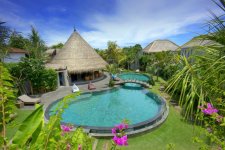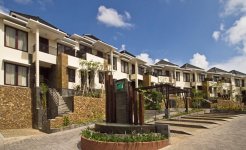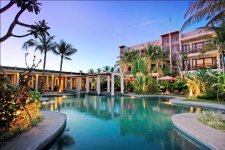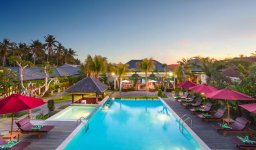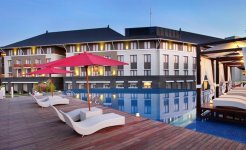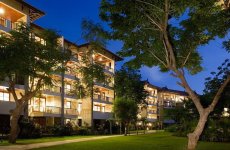.png)
Over 17,000 islands spreading between the pacific and Indian Ocean; More than 200 ethnic groups with over 300 spoken languages bridging the continents of Asia and Australia; a multitude of amazing landscapes and biodiversity stretching along the equator line; this is Indonesia, a land of endless spectacular wonders!
As the largest archipelagic country in the world, Indonesia is blessed with so many different people, cultures, customs, traditions, artworks, food, animals, plants, landscapes, and everything that made it almost like 100 (or even 200) countries melted beautifully into one. Every island here is a unique mixture of natural splendors and different cultures of people who live upon it; from the vibrant tourists’ paradises of Bali and Lombok to the mysteriously shrouded cultures of the Asmat in Papua and those who dwell the highlands of Toraja in South Sulawesi.
Bali (Seminyak)
An essential part of the swathes of stunning beaches along the south coast of Bali next to the vibrant ambience of Kuta, is Seminyak beach and the town of Seminyak, which has its own eclectic mix of world-class restaurants, high end spas, designer boutiques, international surf shops and lifestyle brand outlets.
Seminyak today is Bali's up-and-coming fashion, dining and accommodation precinct, an upmarket coastal enclave just north of Legian and Kuta. Situated some 10km from Denpasar, capital city of Bali, Seminyak stretches from Double Six Street in the south and morphs into the villages of Kerobokan and Umalas, north of Pura Petitenget temple. The atmosphere here is much more sophisticated and laid-back compared to Kuta, while the beach in particular is relatively quieter during the day.
Bali (Kuta)
Once a sleepy village with a quiet, beautiful sweep of beach, Kuta today has become a popular beach destination in its own right, alive with tourists from all over the world, swimming, surfing or sunbathing by the beach. Others, casually dressed in shorts, T-shirts and flip-flops stroll along its main road, shopping around or enjoying meals at its many open air restaurants. When in Kuta you know that you are in a holiday town, and people here are in a holiday mood.
Back in the 1960’s the only hotel was the Kuta Beach Hotel, but soon without much planning, Kuta developed rapidly into a haunt for surfers and backpackers, while the high end market preferred to stay at the more sedate Sanur village on the opposite side of the peninsula. With time, Kuta’s popularity grew, and shops, restaurants, discos hotels, - from the simple to the exclusive - sprang up along the main road from Kuta to Legian, catering to the ever increasing holiday crowd, that not only included international tourists but also domestic visitors from Jakarta and other big cities.
Bali (Nusa Dua)
Nusa Dua situated about 40 km from Denpasar and is the capital of Bali province. Nusa Dua is a sparklingly prestigious, sprawling enclave of international luxury hotels, deluxe spas, exclusive golf courses, and world class convention centers, that was purposely built to present the beauty of the island wrapped in exclusive luxury and also acknowledged as an ideal integrated venue for international conventions and exhibitions.
The crystal clear shallow waters and the pearly soft white sandy beaches surrounding Nusa Dua make it a perfect place to have fun for all members of the family or for tired conference delegates to relax, go swimming and return completely reinvigorated and re-inspired. The name Nusa Dua itself literally translated means 'Two Islands' which refers to the two small raised headlands or islands found just off the coast of the peninsula. On one of the islands stands a Hindu shrine (Pura) called Nusa Dharma which was built in 1948 by Tan Sie Yong of Chinese descent.
Sumatra
Sumatra (also Sumatera) is one of Indonesia's large island and the sixth largest island in the world. Wild and rugged, Sumatra is a blend of Mother Nature extremes, blessed with natural wealth as well as proneness to natural disasters. Volcano eruptions, earthquakes, tsunamis, and landslides are common headline grabbers for this one of the world's richest ecosystems. But nobody can deny Sumatra's beauty from the top of majestic volcanoes to the lush of the jungles and down at sea level, where idyllic deserted beaches are scattered along the island.
Visiting Sumatra can mean never ending action. It has both unique and adventurous activities, starting from the Orangutan sanctuary in Bukit Lawang], some world-class diving sites in Pulau Weh and surfing in the wild Mentawai islands,. You can also enjoy spicy Padang cuisines, relax on the shore of Lake Toba, bag the top of Mount Kerinci of Jambi, stop by the granite beaches of Belitung, and see dolphins at Kiluan, Lampung. The land is also filled with a humungous variety of unique as well as common rainforest fauna. You can spot not only red-haired orangutans, but also all sorts of monkeys that swing on treetops, in addition to Sumatran tigers, rhinoceroses, and elephants.
With almost 40 million inhabitants on this island, the varieties of cultures in Sumatra will also give you non-stop thrills. From the devout Muslims of Aceh, outspoken and friendly Batak people, matrilineal Minangkabau of Padang, sizable Chinese communities of Bangka-Belitung, to semi-primitive tribesmen of Nias; all of them, with their own distinct cultures and languages, living on one island, united by mutual respect for centuries.
Java
Java is Indonesia's fifth-largest island. Its 130 million people make up 65% of Indonesia's entire population, and makes Java the most populated island in the world. Covering an area of 127,569 sq. km (7% of Indonesia's area) and with a population density of 940 people/sq. km, Java is the world's most crowded major island as well.
Jakarta, the capital of Indonesia, is located on northwest region of Java. Surabaya (the second largest city in Indonesia), is located on East Java. Java acts as Indonesia's center of cultural and economic activity.
Java has 121 active volcanoes. Add to that a host of major national parks and, despite its very crowded nature, the island has lots to offer the visitor who appreciates outdoor attractions.
The main ethnic group in Java is Javanese, except for the West Java region where most people are Sundanese. In the province of East Java, 22% of the population is of Madurese descent. Half of them live on the island of Madura.
Jakarta is the capital of Indonesia. Population: 8 million (within city limits). The total population of Jakarta and its suburbs: 12 million people. The population of Jakarta is a mix of many ethnic groups. The group native to Jakarta is Betawi.
Lombok
Located just east of Bali, Lombok in many ways lives up to or exceeds the promotional term, "an unspoiled Bali". With beautiful beaches, enchanting waterfalls, the large, looming volcano of Mount Rinjani combined with relatively few tourists, Lombok is indeed the paradisiacal tropical island that many people still mistakenly imagine Bali to be now.
Lombok and Bali are separated by the Lombok Strait. It is also part of the bio-geographical boundary between the fauna of Indo-Malaysia and the distinctly different fauna of Australasia. The boundary is known as the Wallacean Line, after Alfred Russell Wallace who first remarked upon the striking difference between animals of Indo-Malaysia and those of Australasia and how abrupt the boundary was between the two biomes.
Calling Lombok paradise does not mean it is all things for all people. With a few exceptions, the natural landscape and the traditional way of life have remained unchanged for hundreds of years. Virtually all small to medium size businesses are run by local families. Many of these businesses sell a wide variety of merchandise, where villagers can find food, hardware, and toys all in a single small store. While it is possible to find five-star hotels run by global corporations this is the exception not the rule. The ubiquitous global fast food franchises are restricted to two outlets in the precincts of Mataram Mall in the main City of Lombok and are well sign-posted.
In the Indigenous language of the Sasak people of Lombok the word "lombok" luum-book which literally translates into Bahasa Indonesian as as lurus ("straight ahead").
A common misunderstanding is that the name of the island Lombok is derived from the Bahasa Indonesian meaning of lombok which is chilli or (cabe in Bahasa Indonesian) as is thought by many visitors and some Indonesians from other parts of the archipelago.
Gili Meno
With a population of just 400, Gili Meno is the mellowest of the three islands, and certainly the most in-tune with a desert island ethic. The beaches are much nicer than you will find on Gili Trawangan and Gili Air. It is the ideal island for couples who are looking for nature and romance far away from hustle and bustle.
A coastal path leads all the way around the island, and can be covered at a very leisurely pace in 90 minutes. Most of the tourist facilities, including the boat arrival and departure point, are on the southern part of the east coast.
There is a lake on the western side of the middle of the island. This is sometimes quite full, and at others very dry. It is though always very saline.
Kalimantan (Borneo)
The Borneo rainforest is 130 million years old, making it one of the oldest rainforests in the world and 70 million years older than the Amazon rainforest. Borneo is very rich in biodiversity compared to many other areas. There are about 15,000 species of flowering plants with 3,000 species of trees, 221 species of mammals and 420 species of birds. Subject to mass deforestation, the remaining Borneo rainforest is one of the only remaining natural habitat for the endangered Bornean Orangutan. It is also an important refuge for many endemic forest species, as the Asian Elephant, the Sumatran Rhinoceros, the Bornean Clouded Leopard, and the Dayak Fruit Bat.
Kalimantan has a tropical climate with the average temperature ranging between 23 and 31°C. The island has a high annual precipitation, around 300 mm per year, with a light rainy season between March and May, and a more intense one between November and January. Precipitation levels are however considerably lower than many other neighboring parts of Indonesia


